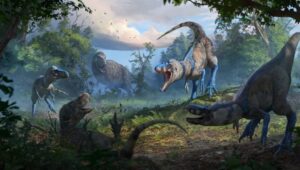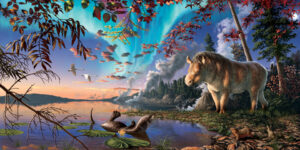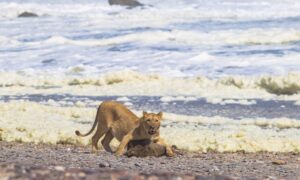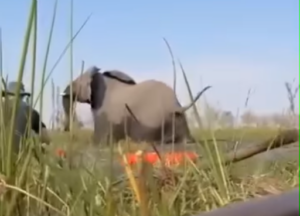Rock art in southern Africa might depict long-extinct animals that walked the Earth 260 million years ago. A new paper argues that we should consider these images a form of Indigenous paleontology.
The horned serpent
The paintings of La Belle France in the Free State Province of South Africa show a long, thin, tusked animal. Called ‘the horned serpent,’ researcher Julien Benoit argues that it is not an image of a fictional creature. Instead, he thinks the 200-year-old drawing illustrates a long-extinct animal that existed 260 million years ago.
Benoit also thinks that the horned serpent is a misleading name. The painting features four stubby legs on the tusked animal. Benoit suggests it might be a painting of a dicynodont (an extinct branch of herbivores that typically bore tusks).
Speaking to the New York Times, Benoit says he first thought the picture might depict a dicynodont when he saw the similarities between rock art and drawings in a book from the 1930s. He then went to South Africa to see the paintings. Seeing the artwork in person, combined with multiple dicynodont fossils nearby, convinced him his theory was correct.
We know that dicynodonts roamed the area millions of years ago, and there are countless fossils of these mammal ancestors across the Karoo Basin.

Image: Julien Benoit
A geomyth
But dicynodonts went extinct long before the indigenous San created the rock paintings, and they depict an animal that Western archaeologists had not yet discovered. Benoit says they are an example of a geomyth. A geomyth involves stories or descriptions of fossils passed from generation to generation, eventually resulting in paintings on the walls of La Belle France.
“This work supports that the first inhabitants of southern Africa…discovered fossils, interpreted them, and integrated them in their rock art and belief system,” Benoit says.
For years, Benoit and other researchers have argued that the Indigenous people were well aware of fossils and geological events. There is evidence that they transported fossils over long distances.
“The San in southern Africa collected fossils, [for example] the Bolahla rock shelter, in which they carried a dinosaur phalanx. This may be…the first time a dinosaur bone was ever discovered,” Benoit told IFL Science. His paper adds more weight to the theory that they were well aware of prehistoric animals.
Hard to prove
San indigenous tales tell of creatures that are bigger than hippos and elephants. This may be what they were talking about. There is not a single animal in Africa that has downturned tusks, but the paintings and dicynodonts do. The rock art also shows dots on the skin of the horned serpent, something that is “consistent with the warty mummified skin preserved in some dicynodont fossils in the area.”
Benoit knows that people will question his study. They will argue that there is no evidence that the San interpreted fossils to create the painting and that it shows a mythical creature. Even if that is the case, Benoit thinks the two could be linked, believing that most myths stem from actual animals.
“Even if one considers that the horned serpent panel has a purely spiritual meaning, it does not invalidate the hypothesis that the San may have imagined the tusked animal based on a dicynodont fossil,” he commented.






